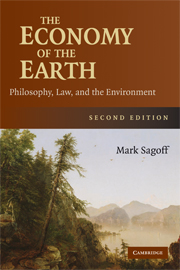Book contents
- Frontmatter
- Contents
- Acknowledgments
- 1 Introduction
- 2 At the Shrine of Our Lady of Fatima or Why Political Questions Are Not All Economic
- 3 The Allocation and Distribution of Resources
- 4 Values and Preferences
- 5 Can We Put a Price on Nature's Services?
- 6 Do We Consume Too Much?
- 7 Is an Environmental Ethic Compatible with Biological Science?
- 8 Settling America or the Concept of Place in Environmental Ethics
- 9 Natural and National History
- 10 Environmentalism: Death and Resurrection
- Notes
- Index
9 - Natural and National History
Published online by Cambridge University Press: 05 June 2012
- Frontmatter
- Contents
- Acknowledgments
- 1 Introduction
- 2 At the Shrine of Our Lady of Fatima or Why Political Questions Are Not All Economic
- 3 The Allocation and Distribution of Resources
- 4 Values and Preferences
- 5 Can We Put a Price on Nature's Services?
- 6 Do We Consume Too Much?
- 7 Is an Environmental Ethic Compatible with Biological Science?
- 8 Settling America or the Concept of Place in Environmental Ethics
- 9 Natural and National History
- 10 Environmentalism: Death and Resurrection
- Notes
- Index
Summary
Of the hundred or so persons who landed with the Mayflower, November 11, 1620, at Plymouth, William Bradford tells us that more than half died in the first two or three months, “especially in January and February, being the depth of winter and wanting houses and other comforts.” The natural environment, as Michael Wigglesworth described it in 1662, was a “Devil's den”:
A waste and howling wilderness
Where none inhabited
But hellish fiends and brutish men
That devils worshiped.
The Bible represents wilderness as otherness – the desert into which Moses and the Israelites wandered, where Christ struggled with Satan, where prophets such as Elijah and John the Baptist fled, and from which voices arose presaging grave events. Bradford and the Pilgrims, John Winthrop and those who migrated to New England during the latter part of the seventeenth century, the fur traders, and after them the hunters, the soldiers, the homesteaders, the empire builders – all learned what we would learn if we visited, even for a short while, an uncivilized place: that nature – and nature meant the wilderness for those people – is
… marvelous, fantastic, beautiful; but it is also terrifying, it is also profoundly sinister. There is something in what, for lack of a better word, we must call the character of great forests … which is foreign, appalling, fundamentally and utterly inimical to intruding man.
- Type
- Chapter
- Information
- The Economy of the EarthPhilosophy, Law, and the Environment, pp. 175 - 193Publisher: Cambridge University PressPrint publication year: 2007

